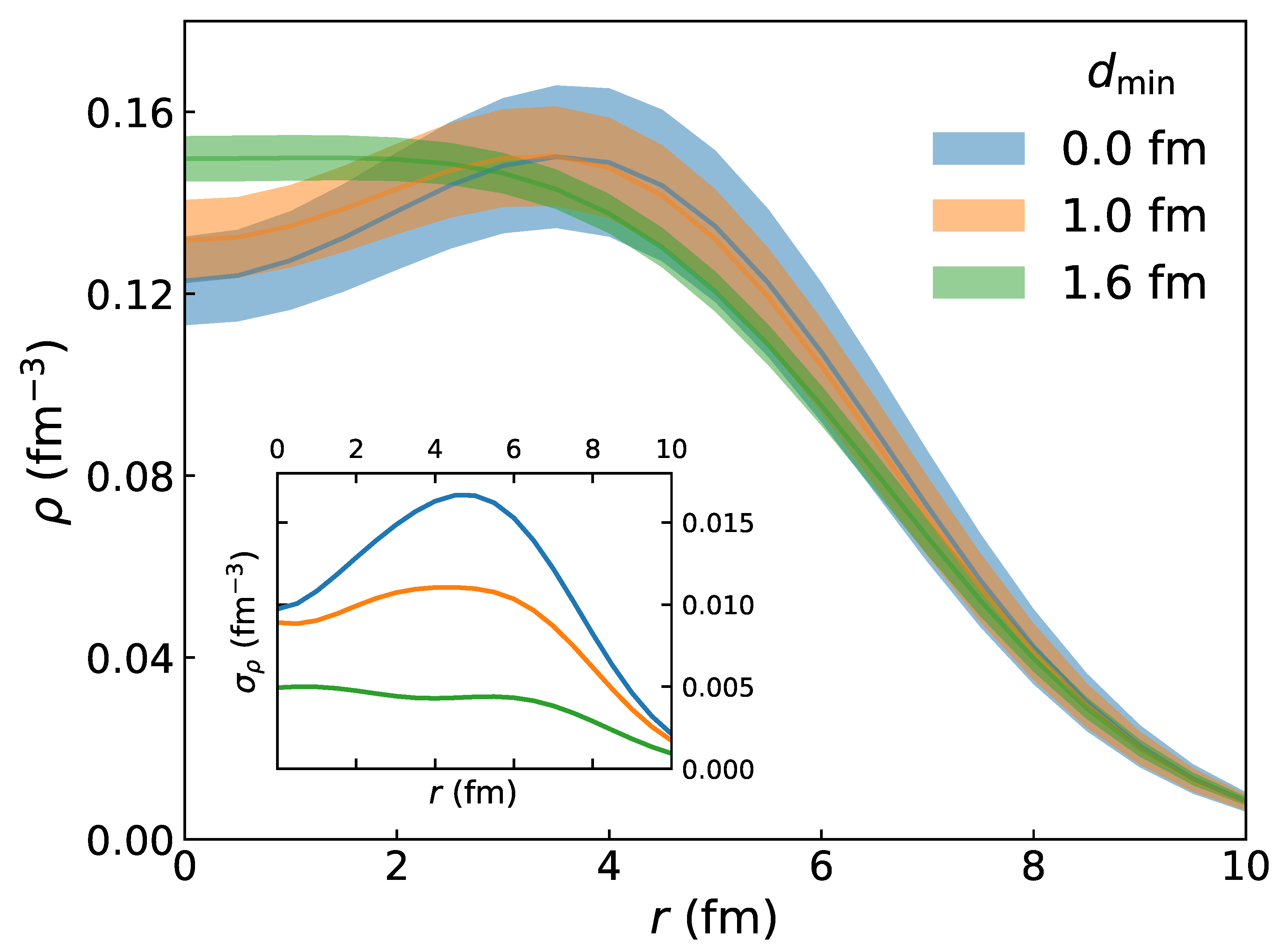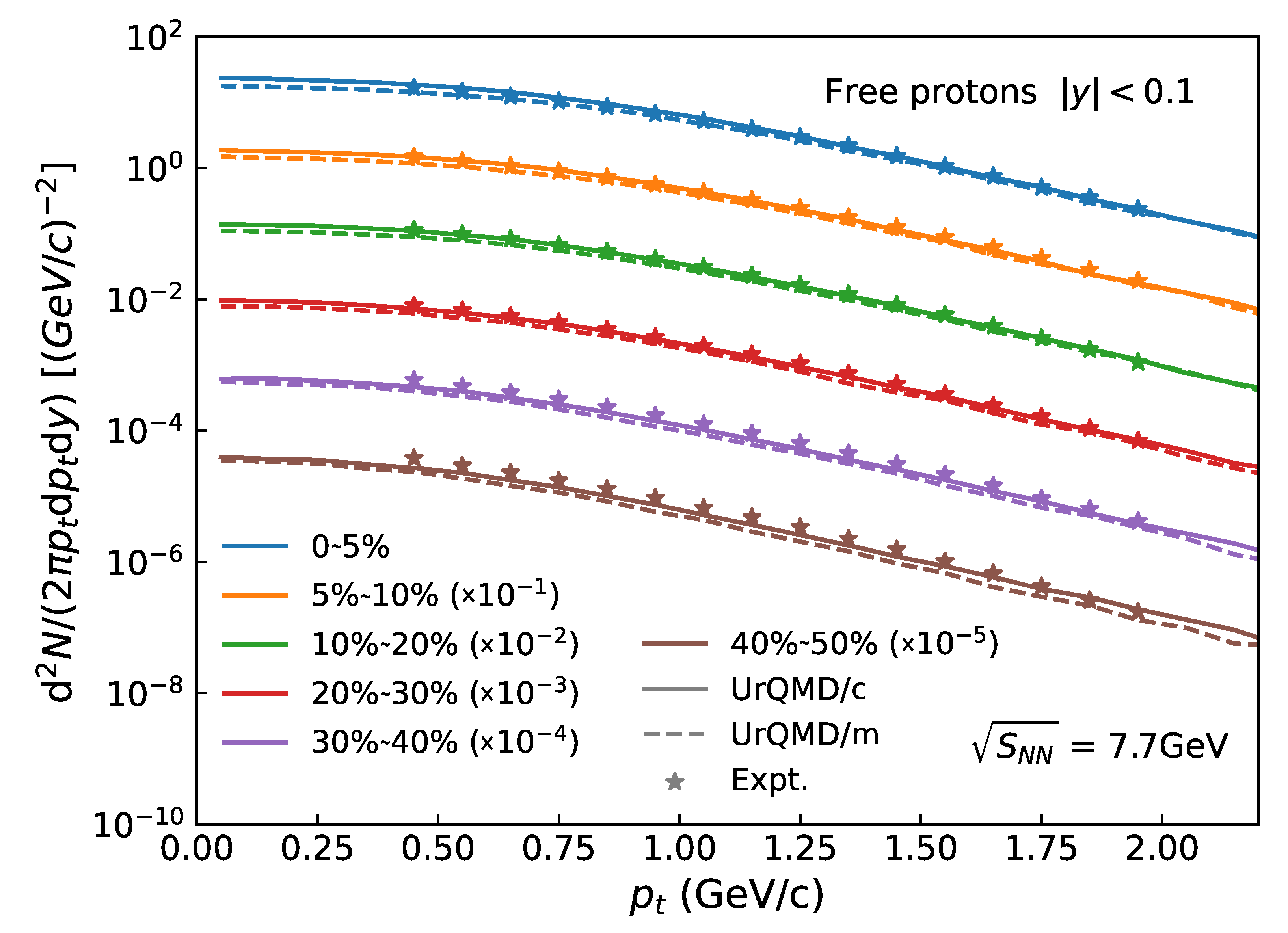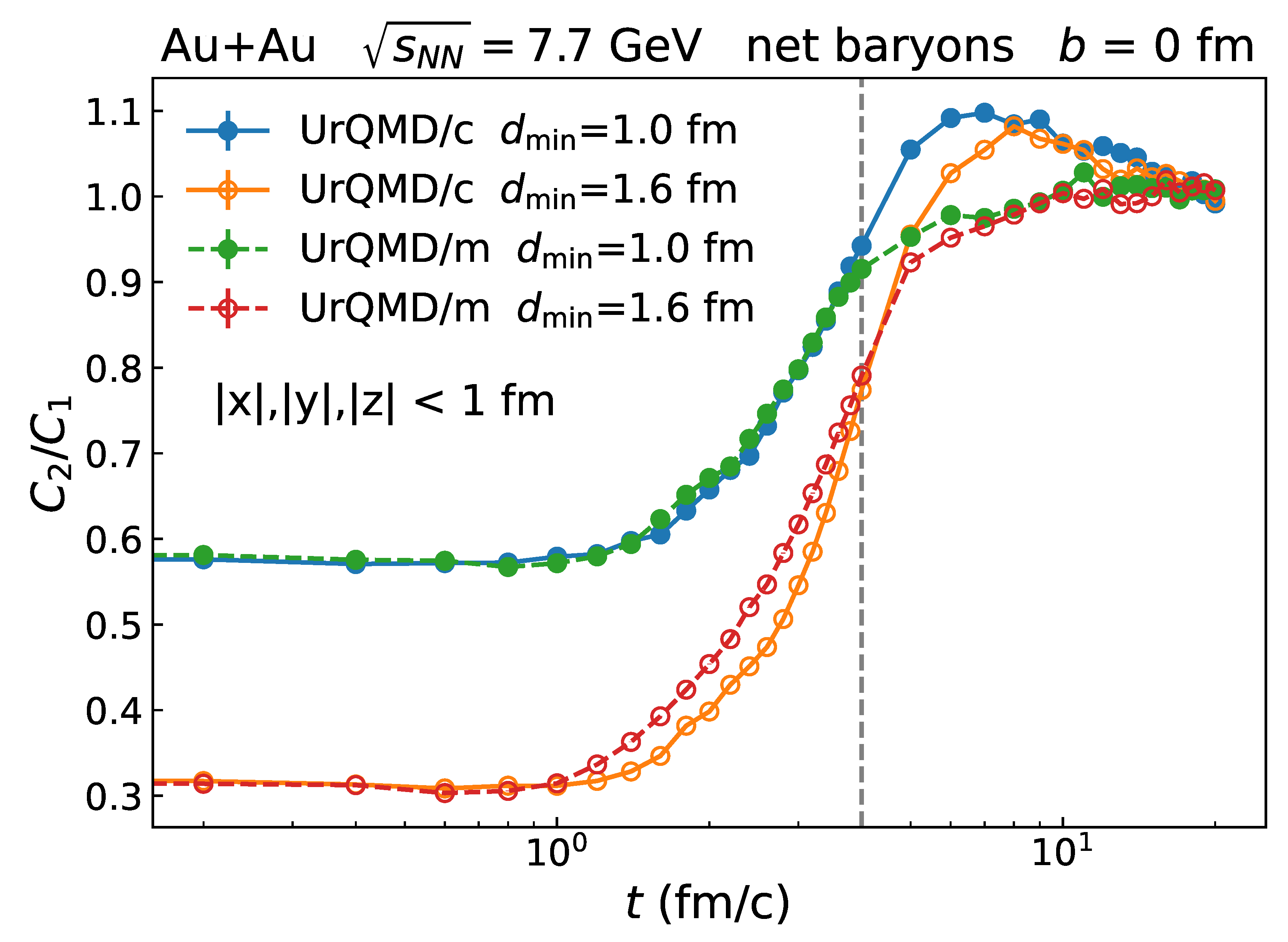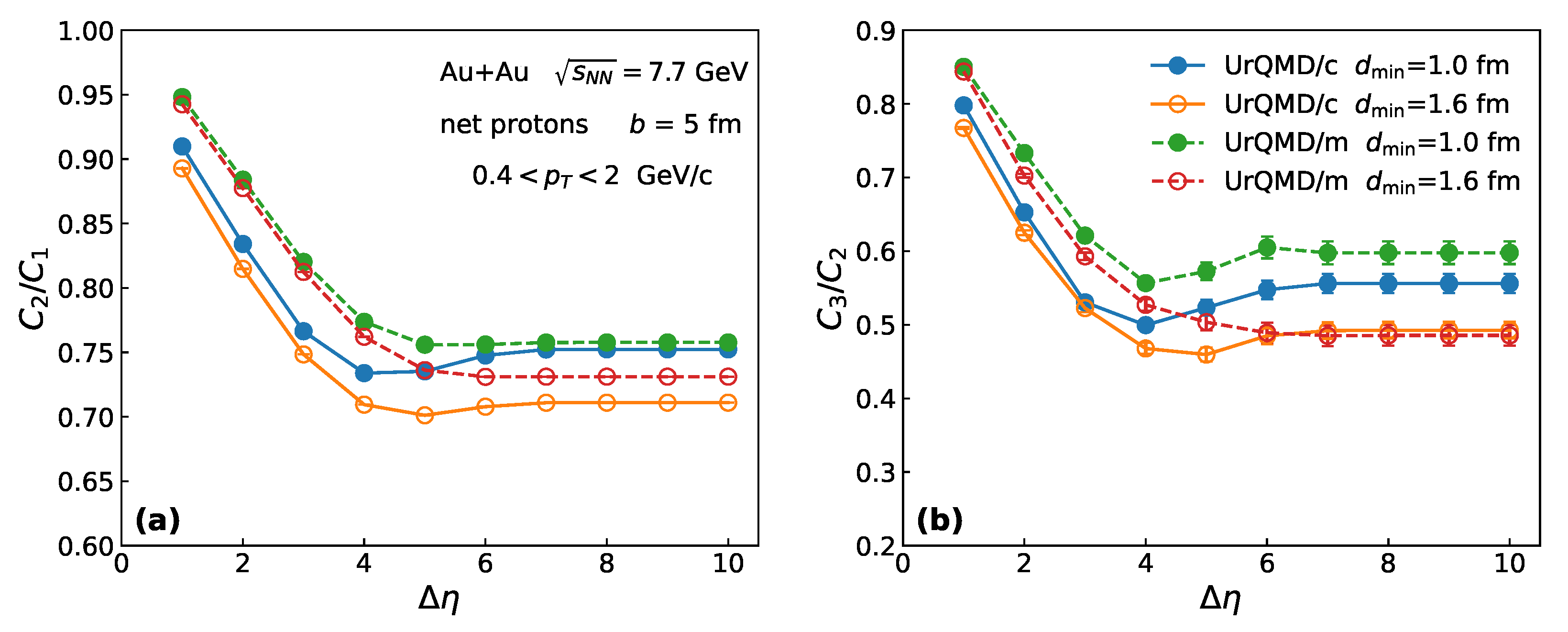Effects of Initial Density Fluctuations on Cumulants in Au + Au Collisions at
Abstract
1. Introduction
2. Initialization of UrQMD Model
3. Fluctuations
4. Results and Discussion
4.1. Results in Coordinate Space
4.2. Results in Momentum Space
5. Summary
Author Contributions
Funding
Data Availability Statement
Acknowledgments
Conflicts of Interest
References
- Aoki, Y.; Endrodi, G.; Fodor, Z.; Katz, S.D.; Szabo, K.K. The Order of the quantum chromodynamics transition predicted by the standard model of particle physics. Nature 2006, 443, 675–678. [Google Scholar] [CrossRef] [PubMed]
- Andronic, A.; Braun-Munzinger, P.; Redlich, K.; Stachel, J. Decoding the phase structure of QCD via particle production at high energy. Nature 2018, 561, 321–330. [Google Scholar] [CrossRef] [PubMed]
- Heinz, U.; Snellings, R. Collective flow and viscosity in relativistic heavy-ion collisions. Ann. Rev. Nucl. Part. Sci. 2013, 63, 123–151. [Google Scholar] [CrossRef]
- Kharzeev, D. Parity violation in hot QCD: Why it can happen, and how to look for it. Phys. Lett. B 2006, 633, 260–264. [Google Scholar] [CrossRef]
- Pandav, A.; Mallick, D.; Mohanty, B. Search for the QCD critical point in high energy nuclear collisions. Prog. Part. Nucl. Phys. 2022, 125, 103960. [Google Scholar] [CrossRef]
- Gupta, S.; Luo, X.; Mohanty, B.; Ritter, H.G.; Xu, N. Scale for the Phase Diagram of Quantum Chromodynamics. Science 2011, 332, 1525–1528. [Google Scholar] [CrossRef]
- Ding, H.T.; Karsch, F.; Mukherjee, S. Thermodynamics of strong-interaction matter from Lattice QCD. Int. J. Mod. Phys. E 2015, 24, 1530007. [Google Scholar] [CrossRef]
- Hatta, Y.; Stephanov, M.A. Proton number fluctuation as a signal of the QCD critical endpoint. Phys. Rev. Lett. 2003, 91, 102003, Erratum in Phys. Rev. Lett. 2003, 91, 129901. [Google Scholar] [CrossRef] [PubMed]
- Luo, X.; Xu, N. Search for the QCD Critical Point with Fluctuations of Conserved Quantities in Relativistic Heavy-Ion Collisions at RHIC: An Overview. Nucl. Sci. Tech. 2017, 28, 112. [Google Scholar] [CrossRef]
- Abdallah, M.; et al. [STAR Collaboration] Cumulants and correlation functions of net-proton, proton, and antiproton multiplicity distributions in Au + Au collisions at energies available at the BNL Relativistic Heavy Ion Collider. Phys. Rev. C 2021, 104, 024902. [Google Scholar] [CrossRef]
- Adamczyk, L.; et al. [STAR Collaboration] Energy Dependence of Moments of Net-proton Multiplicity Distributions at RHIC. Phys. Rev. Lett. 2014, 112, 032302. [Google Scholar] [CrossRef] [PubMed]
- Adamczyk, L.; et al. [STAR Collaboration] Beam energy dependence of moments of the net-charge multiplicity distributions in Au + Au collisions at RHIC. Phys. Rev. Lett. 2014, 113, 092301. [Google Scholar] [CrossRef] [PubMed]
- Xu, N. [STAR Collaboration]. An Overview of STAR Experimental Results. Nucl. Phys. A 2014, 931, 1–12. [Google Scholar] [CrossRef]
- Yang, C. [STAR Collaboration]. The STAR beam energy scan phase II physics and upgrades. Nucl. Phys. A 2017, 967, 800–803. [Google Scholar] [CrossRef]
- Ablyazimov, T.; et al. [CBM Collaboration] Challenges in QCD matter physics—The scientific programme of the Compressed Baryonic Matter experiment at FAIR. Eur. Phys. J. A 2017, 53, 60. [Google Scholar] [CrossRef]
- Kekelidze, V.; Kovalenko, A.; Lednicky, R.; Matveev, V.; Meshkov, I.; Sorin, A.; Trubnikov, G. Prospects for the dense baryonic matter research at NICA. Nucl. Phys. A 2016, 956, 846–849. [Google Scholar] [CrossRef]
- Yang, J.C.; Xia, J.W.; Xiao, G.Q.; Xu, H.S.; Zhao, H.W.; Zhou, X.H.; Ma, X.W.; He, Y.; Ma, L.Z.; Gao, D.Q.; et al. High Intensity heavy ion Accelerator Facility (HIAF) in China. Nucl. Instrum. Methods B 2013, 317, 263–265. [Google Scholar] [CrossRef]
- Skokov, V.; Friman, B.; Redlich, K. Volume Fluctuations and Higher Order Cumulants of the Net Baryon Number. Phys. Rev. C 2013, 88, 034911. [Google Scholar] [CrossRef]
- Xu, H. Cumulants of multiplicity distributions in most-central heavy-ion collisions. Phys. Rev. C 2016, 94, 054903. [Google Scholar] [CrossRef]
- Xu, H. Effects of volume corrections and resonance decays on cumulants of net-charge distributions in a Monte Carlo hadron resonance gas model. Phys. Lett. B 2017, 765, 188–192. [Google Scholar] [CrossRef]
- Li, J.; Xu, H.; Song, H. Noncritical fluctuations of (net) charges and (net) protons from the iEBE-VISHNU hybrid model. Phys. Rev. C 2018, 97, 014902. [Google Scholar] [CrossRef]
- Luo, X.; Xu, J.; Mohanty, B.; Xu, N. Volume fluctuation and auto-correlation effects in the moment analysis of net-proton multiplicity distributions in heavy-ion collisions. J. Phys. G 2013, 40, 105104. [Google Scholar] [CrossRef]
- Sakaida, M.; Asakawa, M.; Kitazawa, M. Effects of global charge conservation on time evolution of cumulants of conserved charges in relativistic heavy ion collisions. Phys. Rev. C 2014, 90, 064911. [Google Scholar] [CrossRef]
- Shuryak, E.; Torres-Rincon, J.M. Baryon clustering at the critical line and near the hypothetical critical point in heavy-ion collisions. Phys. Rev. C 2019, 100, 024903. [Google Scholar] [CrossRef]
- Bzdak, A.; Koch, V. Local Efficiency Corrections to Higher Order Cumulants. Phys. Rev. C 2015, 91, 027901. [Google Scholar] [CrossRef]
- Jia, J. Probing triaxial deformation of atomic nuclei in high-energy heavy ion collisions. Phys. Rev. C 2022, 105, 044905. [Google Scholar] [CrossRef]
- Xu, H.J.; Wang, X.; Li, H.; Zhao, J.; Lin, Z.W.; Shen, C.; Wang, F. Importance of isobar density distributions on the chiral magnetic effect search. Phys. Rev. Lett. 2018, 121, 022301. [Google Scholar] [CrossRef]
- Li, H.; Xu, H.j.; Zhou, Y.; Wang, X.; Zhao, J.; Chen, L.W.; Wang, F. Probing the neutron skin with ultrarelativistic isobaric collisions. Phys. Rev. Lett. 2020, 125, 222301. [Google Scholar] [CrossRef]
- Alver, B.H.; Gombeaud, C.; Luzum, M.; Ollitrault, J.Y. Triangular flow in hydrodynamics and transport theory. Phys. Rev. C 2010, 82, 034913. [Google Scholar] [CrossRef]
- Bass, S.A.; Belkacem, M.; Bleicher, M.; Brandstetter, M.; Bravina, L.; Ernst, C.; Gerland, L.; Hofmann, M.; Hofmann, S.; Konopka, J.; et al. Microscopic models for ultrarelativistic heavy ion collisions. Prog. Part. Nucl. Phys. 1998, 41, 255–369. [Google Scholar] [CrossRef]
- Bleicher, M.; Zabrodin, E.; Spieles, C.; Bass, S.A.; Ernst, C.; Soff, S.; Bravina, L.; Belkacem, M.; Weber, H.; Stoecker, H.; et al. Relativistic hadron hadron collisions in the ultrarelativistic quantum molecular dynamics model. J. Phys. G 1999, 25, 1859–1896. [Google Scholar] [CrossRef]
- Bleicher, M.; Bratkovskaya, E. Modelling relativistic heavy-ion collisions with dynamical transport approaches. Prog. Part. Nucl. Phys. 2022, 122, 103920. [Google Scholar] [CrossRef]
- Wang, Y.; Gao, Z.; Li, Q. Quantifying the Effect of Initial Fluctuations on Isospin-Sensitive Observables from Heavy-Ion Collisions at Intermediate Energies. Symmetry 2021, 13, 2172. [Google Scholar] [CrossRef]
- Wolter, H.; Colonna, M.; Cozma, D.; Danielewicz, P.; Ko, C.M.; Kumar, R.; Ono, A.; Tsang, M.B.; Xu, J.; Zhang, Y.X.; et al. Transport model comparison studies of intermediate-energy heavy-ion collisions. Prog. Part. Nucl. Phys. 2022, 125, 103962. [Google Scholar] [CrossRef]
- Li, Q.; Bleicher, M.; Stocker, H. The Effect of pre-formed hadron potentials on the dynamics of heavy ion collisions and the HBT puzzle. Phys. Lett. B 2008, 659, 525–530. [Google Scholar] [CrossRef]
- Li, Q.; Shen, C.; Guo, C.; Wang, Y.; Li, Z.; Lukasik, J.; Trautmann, W. Nonequilibrium dynamics in heavy-ion collisions at low energies available at the GSI Schwerionen Synchrotron. Phys. Rev. C 2011, 83, 044617. [Google Scholar] [CrossRef]
- Li, P.; Wang, Y.; Steinheimer, J.; Li, Q.; Zhang, H. Proton correlations and apparent intermittency in the UrQMD model with hadronic potentials. Phys. Lett. B 2021, 818, 136393. [Google Scholar] [CrossRef]
- Adamczyk, L.; et al. [STAR Collaboration] Bulk Properties of the Medium Produced in Relativistic Heavy-Ion Collisions from the Beam Energy Scan Program. Phys. Rev. C 2017, 96, 044904. [Google Scholar] [CrossRef]
- Aggarwal, M.M.; et al. [STAR Collaboration] Higher Moments of Net-proton Multiplicity Distributions at RHIC. Phys. Rev. Lett. 2010, 105, 022302. [Google Scholar] [CrossRef]
- Steinheimer, J.; Wang, Y.; Mukherjee, A.; Ye, Y.; Guo, C.; Li, Q.; Stoecker, H. Nuclear interactions and net-proton number fluctuations in heavy ion collisions at the SIS18 accelerator. Phys. Lett. B 2018, 785, 40–45. [Google Scholar] [CrossRef]
- Ye, Y.; Wang, Y.; Steinheimer, J.; Nara, Y.; Xu, H.j.; Li, P.; Lu, D.; Li, Q.; Stoecker, H. Cumulants of the baryon number from central Au + Au collision at Elab = 1.23 GeV/nucleon reveal the nuclear mean-field potentials. Phys. Rev. C 2018, 98, 054620. [Google Scholar] [CrossRef]
- Ye, Y.; Wang, Y.; Li, Q.; Lu, D.; Wang, F. Beam energy dependence of cumulants of the net-baryon, net-charge, and deuteron multiplicity distributions in Au + Au collisions at sNN = 3.0–5.0 GeV. Phys. Rev. C 2020, 101, 034915. [Google Scholar] [CrossRef]






Publisher’s Note: MDPI stays neutral with regard to jurisdictional claims in published maps and institutional affiliations. |
© 2022 by the authors. Licensee MDPI, Basel, Switzerland. This article is an open access article distributed under the terms and conditions of the Creative Commons Attribution (CC BY) license (https://creativecommons.org/licenses/by/4.0/).
Share and Cite
Yue, X.; Wang, Y.; Li, Q.; Liu, F.
Effects of Initial Density Fluctuations on Cumulants in Au + Au Collisions at
Yue X, Wang Y, Li Q, Liu F.
Effects of Initial Density Fluctuations on Cumulants in Au + Au Collisions at
Yue, Xiaoqing, Yongjia Wang, Qingfeng Li, and Fuhu Liu.
2022. "Effects of Initial Density Fluctuations on Cumulants in Au + Au Collisions at
Yue, X., Wang, Y., Li, Q., & Liu, F.
(2022). Effects of Initial Density Fluctuations on Cumulants in Au + Au Collisions at






